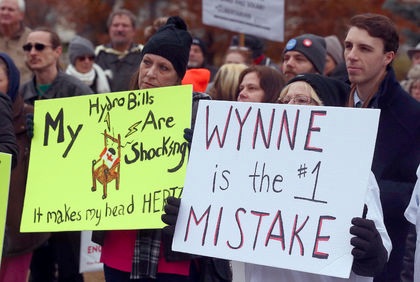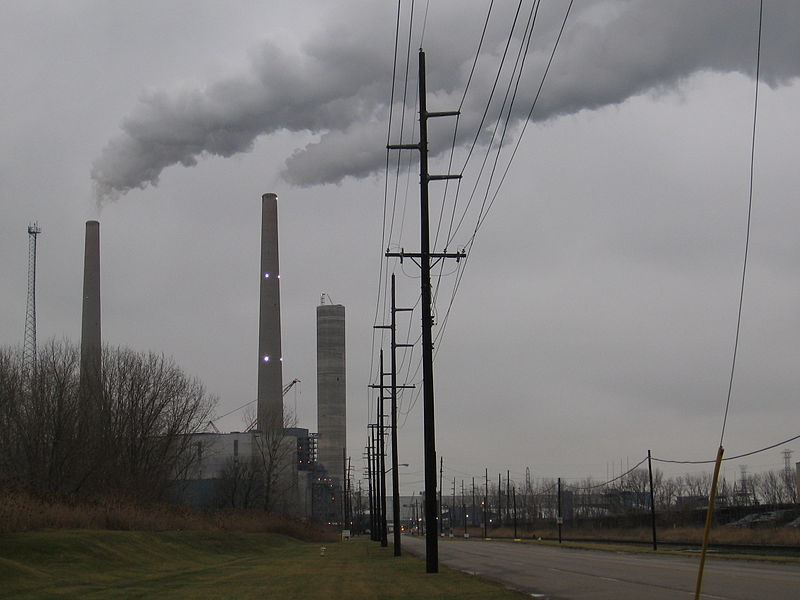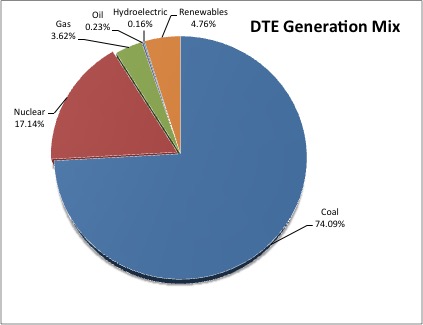Ontario Hydro vs. Michigan Coal: A Cross-Border Perspective on Energy Policy
Michigan’s neighboring state, also known as the Canadian province of Ontario, has been struggling for months with untenable increases in electric rates (what they call “hydro”). It’s gotten so bad that citizens have started organizing protests about bills. Let’s chew on that for a minute: citizens protesting the high cost of energy.
In Michigan, it’s been an uphill battle for me to convince real estate professionals that it’s even worth building to code with regard to insulation and air sealing, industry standard things that people here don’t seem to really believe in. Lansing is lax about commercial code, which is stuck in 2007 ASHRAE, and Detroit simply disregards state law, refusing to enforce IECC 2015, which was adopted formally in February 2016. (This may be a product of BSEED being grossly understaffed). Code noncompliance drives utility bills through the roof, which makes it harder for people to afford rent. Intuitive, right? But people are totally cool with it. One of my co-conspirators and colleagues, Kevin McNeely, jokes that code is the minimum standard necessary if you don’t want to go to jail. Some gems I’ve gotten on the topic of energy and energy bills:
“These people are going to be happy to have a roof overhead,” a union-appointed consultant from the illustrious Shelby Township with the AFL-CIO project told me. “They don’t need all this insulation crap. Trust me, I know. I’ve built hundreds of houses.”
“That’s just not something that’s important to us,” a Detroit nonprofit executive said, when I pitched the portion of my construction and design standards guide outlining the need for R49 insulation and air sealing to 6.0 ACH50, which would lower utility bills and make homes more affordable for low-income homeowners. He continued, “it makes the project unaffordable.” (Plot twist: It doesn’t.)
A commercial landlord shot down my proposal of plugging a gaping hole in the building envelope at my old office. “People here view it as a sunk cost that they’re going to have to pay for anyway, so it’s not worth us spending our money to reduce their costs.” But they had Nest thermostats, so we’re cool. And the property manager of that space told me: “Well, it’ll be spring soon.”
I can’t quite trace the origins of the self-imposed martyrdom that Americans– maybe more specifically Michiganders- embrace when it comes to the complete lack of interest in conservation and complete resignation to literally sending money up a flue pipe. Then again, Detroit’s a weird place. So I was interested in trying to understand some background about energy culture in Ontario.

First, some education for Michiganders who, despite having lived next door to Canada for their whole lives, have only ever been to Windsor once to get drunk when they were 19 and remain largely unfamiliar with the most populous province of America’s Hat: Ontario can be described as comparable to a cross between Pennsylvania, Ohio, and New York State– it hosts the country’s largest city, which Canadians both love and love to hate, it’s got a pleasant mixture of rolling hills, fertile plains along the Great Lakes, Drake, and an expansive Up North that goes on approximately forever (about 15% larger than Texas). It’s got highly urbanized and industrialized corridors with extensive highway and rail infrastructure, and has the largest GDP of any province (oddly not the highest GDP per capita, though, distinctions that fall to Alberta and the Northwest Territories, but that’s a story for another day). The 401, as it is called, is sort of a spiritual hybrid of I-95 and a Midwestern I-80/90.
Canadians refer to electric rates as “hydro” because of the historical widespread prevalence of hydroelectric power. Indulge me for a moment and let’s go on a historical journey to unpack that:


Water is ingrained in the Canadian mythos since forever. While the American pioneer travels west in a covered wagon ‘cross the plains, the Canadian voyageur paddles in a canoe. The American bald eagle soars over the golden prairie while the Canadian beaver beaves in a pristine lake. Canada has a hundred trillion lakes and 7-20% of the world’s fresh water, depending on how you quantify. So, naturally, Canadians are proud of what they’ve got and want to conserve it. A fictional twofer that profoundly illustrates both the classically Canadian inferiority/paranoia complex (about big brother America) and the country’s pride in its water is the 2004 Gemini-nominated, made-for-CBC miniseries H2O, in which the United States essentially annexes Canada to takes it water (and whose main protagonist/antagonist/antihero bears a kind of ridiculous narrative similarity to Justin Trudeau).
So, hydroelectricity availability, indeed, but also water, water conservation, and therefore a culture of conservation, are part of Canadian culture that surrounds the Ontario hydro debate (I hope no Albertans read this, because Alberta, the Texas of Canada, is all about them fossil fuels, so much of this will be irrelevant). More provinces than not generate most of their power from hydroelectric. The Ontario generation mix in 2012 comprised 56.4% nuclear, 22.3% hydro, 3.0% wind, and 2.8% coal, but by 2015-2016 had shifted— zero coal, now 11% wind, 1% solar. Renewable generation expansion was a central tenet of the platform of Premier Kathleen Wynne’s government. They expanded solar through aggressive and extremely generous feed-in tariffs (which funded the development of small solar generation at an inflated rate to incentivize adoption).
The hydro crisis has been widely covered in Ontario, and widely blamed on renewable generation: Wynne’s government finally caved to Conservative Party demands to walk back $3.8bn in renewable purchasing (which will enough on your monthly bill to buy a double double and a donut at Timmy’s). Joe Warmington (some serious nominal determinism for a guy writing about energy usage) lamented “phoney green energy initiatives” in the Toronto Sun, and Lawrence Solomon blasted the “squalid provenance” of the renewable contracts, which, he alleged, amounted to corporate welfare to foreign corporations (vitriolic but not without merit). Wynne’s government has also been mired in controversy related to the heavily-contested development of gas generation plants that began before she took office.
While I lament the complete lack of awareness Michiganders have about the issue, the Canadian media has been lousy at explaining why hydro rates are so high. Untenable increases, citizens increasing debt loads, trying to feed a family, etc., but never a great explanation of the massively complex world that is utility politics, utility financing, infrastructure. I’ve written a lot about the topic of liquidity in real estate: a nuclear power plant, for example, is a rocket ship ride toward the illiquidity end of the spectrum, costing a bazillion dollars to build, requiring a bazillion dollars to operate, and generating a crazy amount of baseload power (thanks, atoms!) and that’s why I don’t work in utility finance. You can’t flip a nuclear power plant like you can a $500 house (I sense a science fiction novel coming on). [Learn some background about baseload vs. peak load.]
Ontario’s bureaucracy is partially to blame, as a sort of Illinoisesque/New Yorkesque Large State that is nominally progressive but problematically large, and its push for progressive energy policy that has invariably driven up costs through things that the media admits is extremely difficult to understand, like the global adjustment cost, or the cap-and-trade system, that I’m fairly sure zero people understand. The socialist party blames the privatization of HydroOne for rising costs, and the Conservative Party said that we could replace cap-and-trade with a carbon tax (can you imagine this debate in the US?).

But here’s the real kicker: Ontario’s distributed rates, which include time-of-day pricing (which normalizes usage during energy-intensive summer days and winter nights), are basically the same as Michigan’s. And, for the most part, we have pretty much the same climate (cold winters, warm summers, lake effect snow in much of Michigan and large portions of Ontario). The distribution rate works out to a different bill across the border, because the province assesses HST on hydro bills while most utility bills in the states are exempted from sales taxes.
A comparative analysis from Quebec Hydro showed that the real distributed rate is actually higher in Detroit than it is in Toronto and actually just under three times what it is in Montreal– (but fails to control for additional taxes owing to the need for uniformity in their survey, indicating that the debate may be somewhat less about generation itself and more about municipal revenue and provincial governance).

DTE recently got approval to hike rates. And people are totally cool with it. At Southwest, I worked with a builder who once told me: “I used to live in a house in Palmer Park, and my utility bill was $800 a month in the winter, and I don’t think there is a single thing that I could have done to lower that bill one bit.” Unfortunately, it is simply not a thing people care about here. $200, $300 a month in bills? Let’s do it!
Although they are lethargically creeping toward increased adoption of solar, DTE notably hasn’t in the past made more than a gestural commitment toward renewables– their generation mix is a garbagefest of coal-fired generation bolstered by a nuclear baseload that is actually more coal-reliant and less nuclear-reliant than the regional (Central/Eastern Midwestern) average. Dig this drab pie chart, wherein coal is making DTEMerica Great Again:
Let’s break it down as a percentage of housing cost:
According to the USEIA, the average monthly utility bill in Michigan is $94.52, below the US national average. At the average Michigan home price of $132,300, that’s a monthly payment of $568.46 principal and interest (10% down at 4.000% over 30 years), of which 17% would be your average monthly utility bill. I don’t know about most people, but I think the notion of getting an up to 17% discount on a house (100% of that if you’re talking about a net zero home) sounds pretty good.
A clever, interactive data set from the National Post shows that even with HST taken into account, the numbers aren’t really that much worse. An average of $188.87 in Windsor-Essex— that’s about $138, which is only about 20% higher than the average US bill (and with 0% coal generation in comparison– Michiganders can take a crack at the question of whether we value that or not). And taking into account the fact that the average home price in Ontario is a whopping $518,000 (egregiously skewed by the rampant clusterfuck of speculation that is the Toronto market), that number looks even smaller as a percentage of the total monthly expense (TO’s regionally adjusted $205.81 out of $2,225.71 a month P&I works out to 9.2% of the monthly cost, in comparison).
Where the stats become absolutely insane is when you look specifically at Detroit. Cut that home price by two thirds and keep the utility bill the same (realistically, increase it, given the degradation of low-income housing in the city, but DTE isn’t exactly all about the open data), and compare to Ontario:
So, in essence, Detroiters could be paying well over 56.41% of their monthly housing payment to utility bills, but we’re fine with that, while our neighbors across the border have in only a couple of years successfully organized a protest movement that has effected the province refinancing its long-term utility debt in order to lower bills.
I can’t speak for the half dozen people who read this blog, nor for the entirety of the Mitten, but I would gladly pay more for electricity if it resulted in cleaner air instead of the filthy air we are relegated to breathing in Southeast Michigan. Or if it resulted in cleaner air, and DTE wasn’t pulling in three quarters of a billion dollars in profit while still upping rates. Or increased resiliency of the grid: CBC reported that the March 2017 windstorm that left thousands of Southwestern Ontarians without power took days longer to fix in Michigan, where about three quarters of a million people were without power for days, owing largely to DTE’s agéd grid (while Ontarians have to choose between feeding their families and paying their hydro bills, we have to choose between $750 million in corporate profits and having modern, resilient infrastructure).
Maybe, in the meantime until we figure out that complicated debate (for example, we wouldn’t want to kick major Detroit polluter US Steel while they’re down), we can remain attentive to the Ontario conversation and figure out ways we can work toward that same culture of energy conservation– which ends up being a value-add for public health and a massive savings in operating capital, whether for households or for businesses. Capital markets are already retooling to accommodate less government subsidy and decreased installation prices in an era with less government green and more demand for green energy– now it’s time to retool our culture in how we think about energy.



